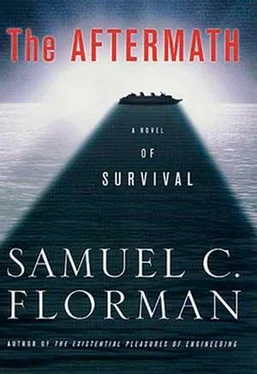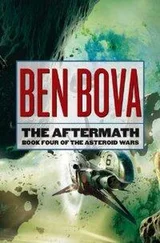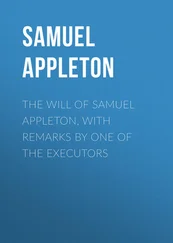Samuel Florman - The Aftermath
Здесь есть возможность читать онлайн «Samuel Florman - The Aftermath» весь текст электронной книги совершенно бесплатно (целиком полную версию без сокращений). В некоторых случаях можно слушать аудио, скачать через торрент в формате fb2 и присутствует краткое содержание. Город: New York, Год выпуска: 2001, ISBN: 2001, Издательство: Thomas Dunne books, Жанр: sf_postapocalyptic, на английском языке. Описание произведения, (предисловие) а так же отзывы посетителей доступны на портале библиотеки ЛибКат.
- Название:The Aftermath
- Автор:
- Издательство:Thomas Dunne books
- Жанр:
- Год:2001
- Город:New York
- ISBN:0-312-26652-9
- Рейтинг книги:5 / 5. Голосов: 1
-
Избранное:Добавить в избранное
- Отзывы:
-
Ваша оценка:
- 100
- 1
- 2
- 3
- 4
- 5
The Aftermath: краткое содержание, описание и аннотация
Предлагаем к чтению аннотацию, описание, краткое содержание или предисловие (зависит от того, что написал сам автор книги «The Aftermath»). Если вы не нашли необходимую информацию о книге — напишите в комментариях, мы постараемся отыскать её.
The Aftermath — читать онлайн бесплатно полную книгу (весь текст) целиком
Ниже представлен текст книги, разбитый по страницам. Система сохранения места последней прочитанной страницы, позволяет с удобством читать онлайн бесплатно книгу «The Aftermath», без необходимости каждый раз заново искать на чём Вы остановились. Поставьте закладку, и сможете в любой момент перейти на страницу, на которой закончили чтение.
Интервал:
Закладка:
Nordstrom gave the most momentous information first. There was a surviving population concentrated in the area around Ulundi, and praise God, there was food. In the near future, the Inlanders—as he labeled the new neighbors—would be sending shipments of vegetables and fruit, and even meat. A great sigh of relief could be sensed among the listeners.
The captain then reported on other matters that had been discussed. Deck Officer Gustafsson and his hosts agreed that it was important to establish joint planning between the Ulundi Indaba and the beachside Governing Council. A Coordinating Committee was to be formed. But how was communication to be maintained after the radio batteries gave out? A community hardly more than a hundred miles across is not large in the scheme of things; yet carrying on a discourse across such a distance presents a troublesome problem.
“The short-term solution,” Nordstrom said, “suggested by Hugh Russell, one of our men in the expeditionary party, is a Pony Express.”
There was a smattering of laughter among members of the Council and observers, but Nordstrom, in his commanding way, obtained silence and continued with his presentation.
It turned out that Russell, a mining engineer from Utah, was also an amateur historian of his home state, and had many facts and figures about the Pony Express ready at hand. When that fabled institution was founded in 1860, Utah, then a territory, contained twenty of the 190 Pony Express stations established between Missouri and California. The celebrated mail service featured riders who typically covered 75 to 125 miles in a single run. The key element was that way stations were established ten to fifteen miles apart, and at these stations the riders were given fresh mounts. In KwaZulu Natal, an ordinary horse could be counted on to gallop at an average speed of twelve miles per hour; so with four or five changes of mount, a message could be carried from Ulundi to the beachfront camp, in about six hours. Of course, racehorses—on a track—can run more than three times as fast; but roads in the African hills were far from racetrack quality. And, unhappily, the province’s prime thoroughbreds were destroyed when the tsunami engulfed the Greyville Racecourse at Durban.
“We will also investigate the possibilities of a semaphore system,” Nordstrom said, “but as a start, the Pony Express it will be.” Seeing that several of the engineers were continuing to smile and shake their heads, he continued: “Scientifically ingenious solutions will be happily accepted, gentlemen. But they have to be workable—now! Right now! And while you’re snickering about America’s Wild West, be advised that we will also borrow from South African frontier history. We have agreed with the Inlanders that we will assist them in trying to resurrect the ox-wagon, the symbol of the Great Boer Trek, which was used during many generations of pre-machine age commerce. Fortunately, the basic roadbeds for railways and highways are in pretty fair condition, even though rails and paving have been swept away by flood or destroyed by fire. Wheeled vehicles may be salvaged; others can be assembled from odd parts. The oxen have survived upland and can be rounded up and put to work.”
Suddenly the captain sighed, took a sip of water, and sat down heavily on a wooden bench. He was exhausted from the almost ceaseless activity and strain of command, and the flippant attitude of some of his high-tech passengers was obviously grating on his nerves.
The momentary silence was broken by John Hertzler, who spoke in a loud voice but clearly was sensitive to Nordstrom’s annoyance.
“We want to be helpful, Captain,” he said. “And we recognize that right now we have to rely on primitive ways of doing things. But at the same time, we want to move to higher technological levels as soon as possible. And in order to do this, we have to know what materials are available for us to work with. When we met the other day, one of our South African engineers was telling us about the area’s natural resources; but his presentation was limited to agriculture and animals.”
At this point, Hertzler turned to Dr. Wilson Hardy for help. “You know, Wilson, you promised us that this fellow Marshall was going to fill out the picture for us. How about it? What are our prospects of working our way out of the horse-and-buggy age?”
“You’re right, John,” said Hardy. “Pieter Kemm gave us his report, and said that Kelvin Marshall would fill us in on the mineral resources.” Then, turning around to look for Marshall, he said, “I guess this is as good a time as any. Assuming Captain Nordstrom agrees.”
The captain wearily waved his assent.
Kelvin Marshall was a tall, heavy, ruddy-faced man with thin, graying hair, who rose with difficulty from where he had been sitting in the sand. The manufacture of chairs was not yet a high priority among the survivors.
“If you’re looking for mineral resources,” he began, “you’ve come to the right place. We have it all, and in huge amounts: coal and iron, copper and nickel, lead and zinc, tin and platinum, silver and gold, and on and on. Also everything you need for building: lime, clay, gypsum, and different kinds of stone. You may not want rare and strategic metals right away, but for those materials we are numero uno, a veritable global headquarters. I have the figures right here.” He referred to a sheet of paper on which he had scribbled some notes. “Manganese—eighty-one percent of the world reserves; chromium—sixty-eight percent; vanadium—forty-five percent; zirconium—twenty-six percent; titanium—seventeen percent; and more.
“Ready for atomic energy? Well, when you are, we have six percent of the uranium known to be in the earth. We also have proven reserves of natural gas. The only thing that we do not have—and I’ll be the first to admit it—is petroleum. But that’s where my company, Sasol, comes in. We are—or were—the only people in the world to have developed an economical process for converting coal into liquid fuel. Thanks to the international boycott that deprived us of petroleum imports during the apartheid days, we solved our problem through technology. At the moment, our factories are doubtless burned to cinders like practically every other structure on the face of the globe. But the knowledge is preserved in our plans and manuals, many of which I brought with me for the seminar—and up here,” he said, smiling, tapping the side of his head with his index finger.
“Let me add,” he continued, “that in addition to petroleum, we have ethanol. We make it from sugar cane, and for years we’ve been adding two to four percent ethanol to all our petrol. Until about 1970, we used ethanol—with the trade name Union—as an alternative fuel. Speaking of sugar, we also make an alcoholic drink called Cane Spirit. Sort of like vodka. If your car runs out of fuel, and you’ve got a bottle of that stuff with you, no problem. You pour it in your tank, and it’s sure to get you home.”
General White of the Army Engineers stood and asked to be recognized. “You know, Wilson,” he said, addressing Dr. Hardy, “I can see that you and Hertzler and a few others are having a good time planning the world of the future, complete with skyscrapers, computers, and airports. But let me remind you that we are scrambling around on this beach trying to provide some shelter for twenty-five hundred needy people, and we’re working with turned-over lifeboats, odd pieces of driftwood, some blankets, a few patches of canvas, and just about any bit of useful debris we can find. It doesn’t do us a damned bit of good to know that there’s a whole bunch of coal in the ground when it’s not next door, and all we’ve got to dig with is a few sticks.”
“I take your point, General,” Hardy replied. Even-tempered by nature, he had promised himself not to allow difference of opinion and dissent to make him angry when he was presiding with Captain Nordstrom over these discussions. “Pieter and Kelvin, what do you think our prospects are for actually getting at all this wonderful stuff that lies underground? As the general says, we do have immediate needs to balance against hopes for the future.”
Читать дальшеИнтервал:
Закладка:
Похожие книги на «The Aftermath»
Представляем Вашему вниманию похожие книги на «The Aftermath» списком для выбора. Мы отобрали схожую по названию и смыслу литературу в надежде предоставить читателям больше вариантов отыскать новые, интересные, ещё непрочитанные произведения.
Обсуждение, отзывы о книге «The Aftermath» и просто собственные мнения читателей. Оставьте ваши комментарии, напишите, что Вы думаете о произведении, его смысле или главных героях. Укажите что конкретно понравилось, а что нет, и почему Вы так считаете.












